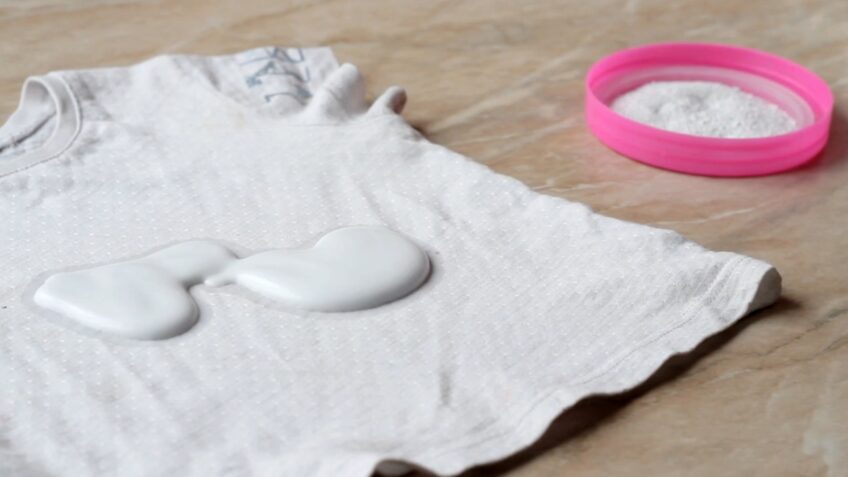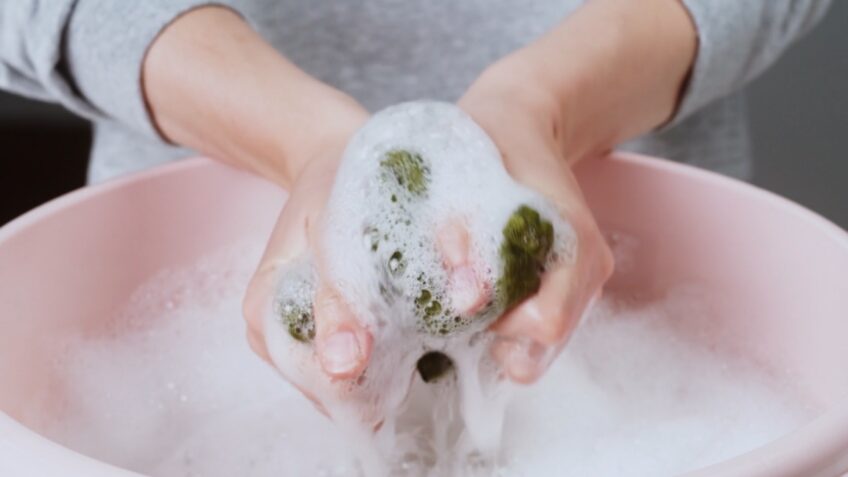We’ve all been there: whipping up a delicious meal in the kitchen, only to have a splash of cooking oil land on our favorite shirt or pair of pants. It can be frustrating, but don’t worry—you’re not alone. Grease stains are a common problem that can plague even the most careful of cooks. But fear not! In this comprehensive guide, we’ll reveal the secrets to removing cooking oil from clothes effectively, so you can keep your garments looking fresh and clean.
Understand the Science
Before we delve into the various techniques for removing them, let’s first understand why they are so stubborn. Oil and water don’t mix, which is why your regular washing routine may not always be effective in removing these stains. It is a hydrophobic substance, meaning it repels water, while fabric fibers are usually hydrophilic, attracting water.
The combination of oil and fabric creates a bond that can be tough to break. If you’ve just spotted the oil stain on your clothing, act quickly! The sooner you treat the stain, the better your chances of removing it entirely. Follow these steps:
- Remove any excess oil by blotting the stain with a clean, dry cloth or paper towel.
- Be gentle and avoid rubbing, as this can spread the oil further into the fabric.
- Sprinkle cornstarch, talcum powder, or baking soda on the stain to absorb the oil.
- Let it sit for at least 15 minutes, and then gently brush the powder away.
This step will help to lift some of the oil out of the fabric fibers before you begin the cleaning process.
Pre-Treatment Solutions

Before tossing your stained garment into the washing machine, try these pre-treatment methods to help break down the oil and make it easier to wash out:
- Dish soap: Apply a few drops of liquid dish soap (preferably a grease-fighting formula) directly to the stain. Gently rub the soap into the fabric with your fingers or a soft toothbrush. Let it sit for at least 15 minutes before washing.
- Laundry pre-treatment spray: Many commercial laundry sprays are designed specifically for oil and grease stains. Apply the spray according to the manufacturer’s instructions, and let it sit before washing.
- Vinegar solution: Mix equal parts white vinegar and water, and gently dab the solution onto the stain with a clean cloth. Allow it to sit for 15 minutes before washing.
- Choosing the Right Detergent: Not all detergents are created equal when it comes to tackling grease stains. Look for a heavy-duty laundry detergent that is specifically formulated to remove oil and grease. These detergents often contain enzymes that help break down the oil molecules, making them easier to wash away.
Washing Tips

Now that you’ve pre-treated your garment, it’s time to wash it. Follow these tips for the best results:
- Check the care label: Always follow the washing instructions on your garment’s care label. Some fabrics may require a specific water temperature, cycle, or even dry cleaning.
- Use hot water: Washing your clothes in the hottest water temperature recommended on the care label will help dissolve the oil more effectively. If you’re unsure, opt for warm water to avoid damaging your garment.
- Add extra detergent: For particularly stubborn stains, you may want to use a little more detergent than usual to help break down the oil. Wash separately: To prevent the oil from transferring to other garments, wash the stained item separately or with similarly stained items.
- Repeat if necessary: If the stain hasn’t completely disappeared after the first wash, don’t panic. Simply repeat the pre-treatment and washing process until the stain is gone.
- Avoid drying the garment until you’re satisfied with the results, as heat can set the stain permanently.
Post-Wash Care
Now that your clothes are oil-free, here are some tips to help prevent future stains:
- Wear an apron: When cooking, wearing an apron can help protect your clothes from oil splatters and spills.
- Use a splatter guard: A splatter guard is a handy tool that can be placed over your frying pan to minimize oil splashes.
- Cook at lower temperatures: Cooking at lower temperatures can reduce the likelihood of oil splatters. Be patient and take your time when frying or sautéing.
- Be mindful of your surroundings: When handling oil, be aware of your clothes and take extra care not to spill or splash.
Avoiding common mistakes
One of the most common mistakes is using hot water to rinse the stain, which can actually set the stain into the fabric instead of removing it. It is also important to avoid rubbing the stain too vigorously, as this can cause it to spread and penetrate deeper into the fibers of the fabric.
Another mistake to avoid is using bleach or bleach-based products on the stain, as this can cause discoloration and damage to the fabric.
Additionally, it is important to avoid using harsh chemicals or solvents, as these can also damage the fabric and potentially harm your health. Instead, a more effective method for removing cooking oil stains is to use a combination of dish soap and baking soda.
First, blot the stain with a paper towel to remove as much excess oil as possible. Then, mix a small amount of dish soap and baking soda together to create a paste, and apply it to the stain. Let the paste sit for a few minutes before rinsing with cold water and washing the garment as usual.
Alternative cleaning methods for cooking oil stains
They can be notoriously stubborn and difficult to remove, especially if they have been left untreated for too long. However, there are alternative cleaning methods that can be used to effectively remove cooking oil stains from clothes. An alternative method involves using dish soap and hydrogen peroxide.
Mix a tablespoon of dish soap and a tablespoon of hydrogen peroxide in a small bowl. Apply the mixture onto the stain and let it sit for 5-10 minutes. Rinse with cold water and repeat the process if necessary. For delicate fabrics, such as silk or wool, try using cornstarch or baby powder to absorb the excess oil. Sprinkle the powder onto the stain and let it sit for 30 minutes. Brush off the powder and repeat the process if necessary.
FAQs

Can rubbing alcohol remove old oil stains?
A: Rubbing alcohol can help break down some oil stains. Dampen a clean cloth with rubbing alcohol and gently dab the stain before washing. Note that this method may not be effective for all types of stains and fabrics, so always test on a hidden area first.
How do I know if a detergent is suitable for removing oil stains?
Look for heavy-duty laundry detergents that are specifically formulated to remove them. These detergents often contain enzymes that help break down molecules, making them easier to wash away.
Can I use a stain stick or bar to remove set-in oil stains?
Yes, stain sticks or bars specifically designed to tackle grease and oil stains can be effective. Follow the manufacturer’s instructions to apply the product to the stain, and then launder as usual.
Can I use a steam cleaner to remove old oil stains?
Steam cleaners can help to loosen them, but they may not completely remove them. It’s best to use a pre-treatment method followed by laundering to effectively remove them from your garments.
How can I tell if an oil stain is completely removed before drying?
Inspect the garment carefully under good lighting to check for any remaining traces of the stain. If the stain is still visible, repeat the pre-treatment and washing process. Avoid drying the garment until you’re satisfied with the results, as heat can set the stain permanently.
How do I remove oil stains from delicate or non-washable fabrics?
For delicate or non-washable fabrics, it’s best to consult the care label for specific cleaning instructions. You may need to take the garment to a professional dry cleaner to ensure proper stain removal without damaging the fabric.
Conclusion
Grease stains can be a nuisance, but with the right techniques and a little perseverance, you can keep your clothes looking fresh and clean. By understanding the science behind oil stains and applying effective pre-treatment methods, choosing the right detergent, and following proper washing tips, you’ll be well-equipped to tackle even the most stubborn cooking oil stains. And by taking preventive measures, you can minimize the risk of future stains and maintain a pristine wardrobe. Remember, the key to success is acting quickly and treating the stain as soon as possible. With this comprehensive guide in hand, you can confidently banish grease stains from your clothes and get back to enjoying your culinary creations.

